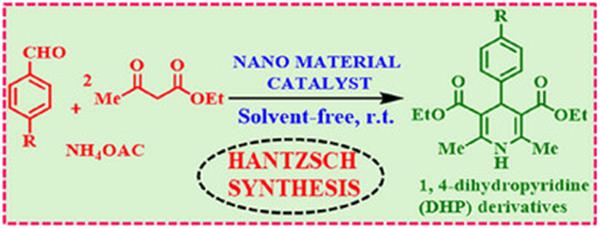Recent Advances in the Synthesis of Dihydropyridine and Their Corresponding Fused Systems via Multi‐Component Hantzsch Reaction Using Catalytic Nanomaterials
writer:Gnanamani L, Shareefa bee A, Madhu S, Venkatesan K, Annamalai P, Jianli W, Mohamad Ali
keywords:1,4-Dihydropyridine,Hantzsch synthesis , Multicomponent reaction,Nanocatalysts,Sustainable chemistry
source:期刊
specific source:ChemistrySelect
Issue time:2024年
1,4-二氫吡啶(1,4-DHPs) 是一類結構多樣的吡啶衍生有機化合物,因其廣泛的合成應用價值和顯著的藥物相關性而備受關注。經典的 Hantzsch 二氫吡啶合成法仍是構建此類雜環骨架的核心方法。近期創新技術徹底革新了 Hantzsch 二氫吡啶及其結構類似物的合成方案。本綜述系統評述了 1,4-DHPs、1,8-二氧十氫吖啶(AD)和多氫喹啉(PHQ)合成領域的前沿進展,重點探討了以醛類、β-酮酯和銨鹽為前體的新興多組分反應(MCR)策略。
特別值得注意的是,本文著重介紹了基于先進納米催化體系的突破性進展,包括磁性納米雜化材料、納米結構復合材料、過渡金屬氧化物、表面工程納米粒子及生態兼容型納米生物材料。納米催化劑的策略性應用展現出增強的結構精確性與催化性能,標志著向可持續合成化學的范式轉變。通過對納米催化劑介導的合成路徑進行批判性分析,本研究闡明了其在優化 1,4-DHPs 合成反應動力學、區域選擇性和整體工藝效率中的機制作用。文中提出的發現為采用定制納米催化劑的下一代 Hantzsch 反應工程奠定了基礎,有望為 1,4-DHP 衍生藥效團的綠色合成開辟新途徑。
1,4-Dihydropyridines (1,4-DHPs) represent a versatile class oforganic compounds derived from pyridines, recognized fortheir extensive synthetic applications and significant medi-cal significances. Among the various synthetic methodologiesavailable, the Hantzsch dihydropyridine synthesis is particularlynotable as it provides a reliable approach to the produc-tion of these compounds. Recent advancements have markedlyimproved the synthetic pathways leading to Hantzsch dihy-dropyridines and their derivatives. This review aims to thor-oughly examine the recent progress in the synthesis of 1,4-DHPs, 1,8-dioxodecahydroacridines (AD), and polyhydroquino-lines (PHQ). Emphasis is placed on novel synthetic strategiesreported in recent years, specifically those that employ mul-ticomponent reactions involving aldehydes, β-ketoesters, andammonium salts. Furthermore, these reactions are catalyzedby various nanocatalysts, including magnetic nanoparticles,nanocomposites, metal oxides, functionalized nanoparticles, andother environmentally friendly nanobiomaterials. The applica-tion of nanocatalysts in these processes is underscored by theircontributions to structural integrity and activity enhancement,indicative of a paradigm shifts towards more sustainable andefficient synthetic methodologies. This review consolidates andassesses various synthetic routes facilitated by nanocatalystswhile elucidating their distinct roles in improving the efficiencyand selectivity of 1,4-DHP synthesis. Hence, this review may pavethe way for advancements in Hantzsch reactions by employingnanomaterial catalysts for the sustainable production of 1,4-DHP derivatives.
